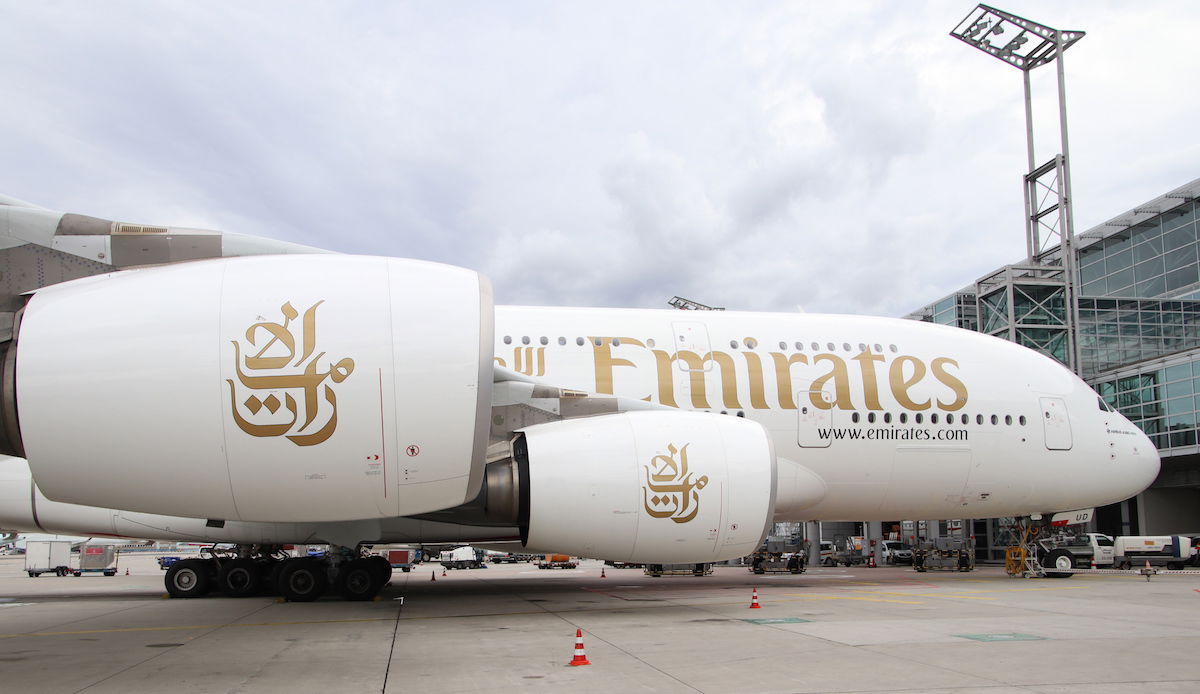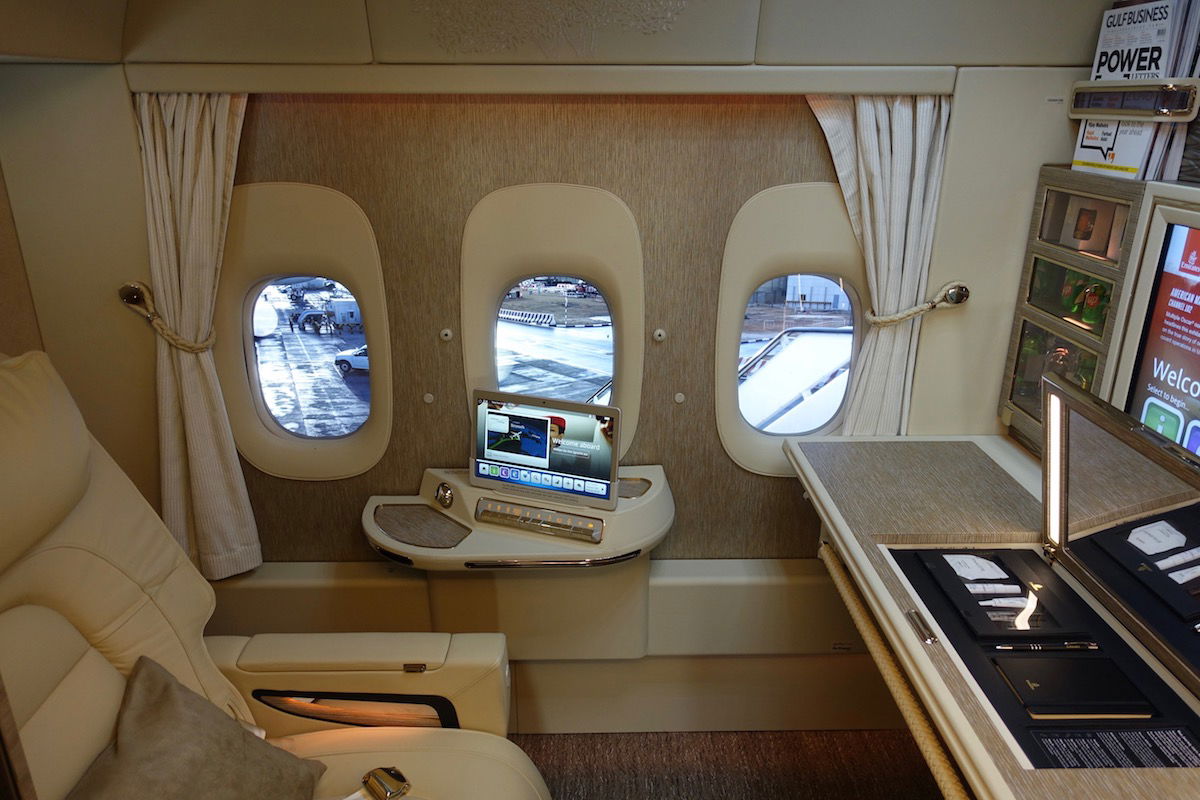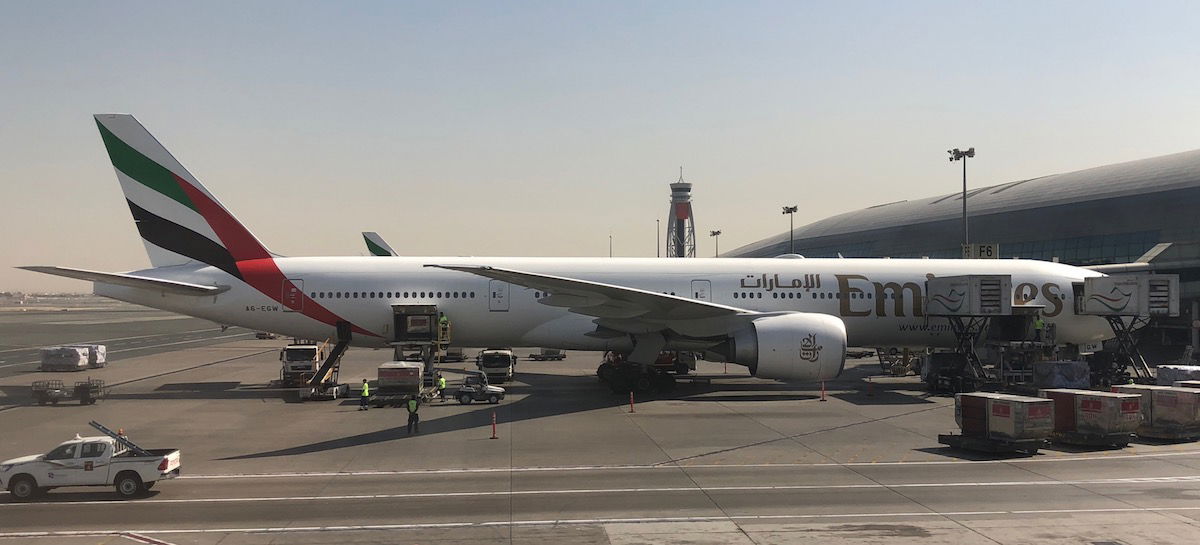In March Etihad reported their awful financial results from last year, as the airline lost $1.28 billion, bringing their losses over the past three years to nearly $5 billion. The worst part is that this came after Etihad already engaged in a significant cost cutting program, which shows you just how much work they have ahead of them.
Well, today Emirates has revealed their financial results for the past financial year, ending March 31, 2019. They did much better than Etihad.
Emirates reports $237 million profit
I’m going to be sticking solely to Emirates results here, rather than results from Emirates Group, which includes dnata (their airport services provider). Emirates reported a $237 million profit this past year:
- Emirates profits are down 69% compared to the previous year
- The $237 million profit represents a 0.9% profit margin
 Emirates A380
Emirates A380
Why Emirates profits decreased
Emirates attributes the decreased profits to the following:
- Stiff competition across key markets
- Unfavorable currency impacts, as the USD strengthened relative to many of Emirates’ key markets, which they estimate cost them $156 million; interestingly the previous year Emirates estimates a $180 million positive impact from currency fluctuation
- Increased fuel costs, as the average price of jet fuel increased by 22%, after increasing by 15% the year prior; Emirates’ fuel bill for the year was $8.4 billion, which accounts for 32% of their operating costs
 Emirates’ new 777-300ER first class
Emirates’ new 777-300ER first class
Key figures of Emirates’ performance
Let’s look at a few other key figures for Emirates for this past year:
- Revenue increased by 6%, to $26.7 billion
- Seat capacity increased by 4%
- Emirates increased their fleet by a net of two planes, as they took delivery of 13 planes (seven A380s and six 777-300ERs) and retired 11 planes
- The average fleet age of Emirates’ 270 planes is 6.1 years
- Emirates carried 58.6 million passengers (up 0.2%)
- The average load factor was 76.8%, down slightly from 77.5% the previous year
- The average passenger yield increased by more than 3% to 7.1 US cents per revenue passenger kilometer
It’s also interesting to note how different regions contributed towards Emirates’ revenue, with no region contributing more than 30%:
- Europe generated $7.7 billion in revenue (up 6%)
- East Asia and Australasia generated $7.2 billion in revenue (up 5%)
- The Americas generated $3.9 billon (up 8%)
- Africa generated $2.8 billion (up 9%)
- Gulf and Middle East revenue generated $2.3 billion (down 3%)
- West Asia and Indian Ocean revenue generated $2.2 billion (up 6%)
 Emirates took delivery of their last 777-300ER this past year
Emirates took delivery of their last 777-300ER this past year
Is this all just fake math?
When I write about the financial performance of the Gulf carriers, there are always questions about whether this is all just imaginary math, given that the Gulf carriers are state owned.
After all, US airlines have spent millions of dollars trying to convince us that these are heavily subsidized airlines that are losing billions of dollars.
My personal take is that these results are mostly accurate. After all, Emirates results are independently audited per international financial reporting standards.
However, there’s no denying that airlines like Emirates have benefited from some things over the years:
- No doubt they’ve had easier access to financing on account of being government owned, which has allowed them to grow as much and as quickly as they have
- They largely have lower operating costs than other airlines, given that they essentially have the same owner as the airport, ground handlers, catering company, etc.
I do think Emirates is “legitimately” profitable. The problem with the A380 for most airlines is that they haven’t been able to scale their operations in a way that works. Emirates has been able to scale their route network unlike any other airline.
Obviously Etihad and Qatar don’t have similar success, as both airlines are losing a lot of money.
While we’re talking about airlines having advantages on account of the countries they’re based in, let’s keep in mind how US airlines have benefitted from bankruptcy protection, at the expense of employees and creditors (just ask US airline employees from a couple of decades ago about their pensions).
Bottom line
All things considered, Emirates’ performance for the past year is pretty impressive, especially when you consider the currency issues and increased fuel prices they’ve dealt with. While their rivals continue to lose money (Etihad because they’re a basket case, and Qatar because of the blockade, and some other factors), Emirates has scaled their route network in a way that makes sense.





@Mike
Your sense of humor is outstanding
Etihad is owned by the largest sovereign fund in the entire planet. Emirates is probably the or one of the best managed airlines in the world. Qatar is no much different than Etihad in terms of resources. If they wish they can sustain losses for the next hundreds years (but they won’t need to).
Today Emirates is the largest airline for international routes and I don’t see...
@Mike
Your sense of humor is outstanding
Etihad is owned by the largest sovereign fund in the entire planet. Emirates is probably the or one of the best managed airlines in the world. Qatar is no much different than Etihad in terms of resources. If they wish they can sustain losses for the next hundreds years (but they won’t need to).
Today Emirates is the largest airline for international routes and I don’t see this changing any time soon. Turkish is an outstanding airline and there’s little doubts about that.
Causing bankruptcy? Really? On which assumption? Because of the new airport?
Turkish Airlines will put all three in bankruptcy within 3 years. New airport, huge currency advantage, better location are all insurmountable advantages.
"Etihad because they're a basket case" was a rather rude remark but surely it should be more accurately presented as "Etihad, like Gulf Air, because they placed grossly misguided trust in James Hogan".
“Etihad because they’re a basket case” - nuff said.
@AdamR
It is actually correct to factor in currency exchange. Nothing fake here. Imagine later in 2019 The GBP crashed due to brexit and 1 GBP is now only 0.13 USD. That means all the tickets sold in GBP just became 10% of what it used to be. Now gain/loss on exchange can affect the valuation but it is nothing EK can manipulate, better yet if EK are good at FOREX hedging, they could even...
@AdamR
It is actually correct to factor in currency exchange. Nothing fake here. Imagine later in 2019 The GBP crashed due to brexit and 1 GBP is now only 0.13 USD. That means all the tickets sold in GBP just became 10% of what it used to be. Now gain/loss on exchange can affect the valuation but it is nothing EK can manipulate, better yet if EK are good at FOREX hedging, they could even make money from it. Now when they say EK is free from subsidy, you need to look closer at there wage bill, cost of fuel, and interest rates. That is where the subsidy goes hidden. Government can't just write checks just because.
I’ve always been surprised that Emirates make the money they claim to.
EK has a very different cost base. Aircraft cleaners, gate agents, mechanics cost a fraction of the legacy airlines. And they enjoy massive economies of scale at DXB.
There is hardly any holding on arrival since the airspace was restructured several years ago. Very rare to get more than 1 hold nowadays.
Whilst you may get caught anecdotally in a longer hold, the average is really quite low.
In any case, there is 99% chance of a 5 min shortcut on the STAR.
I do wonder how much it costs for the daily holding at DXB for landing and whether the costs of holding compared with let's say a hi speed rail link to DWC.
I think there are merits in using both airports to reduce fuel costs. Considering walking end to end at DXB can take 25-40 mins I think a high speed rail link would be 10mins end to end.
Love Emirates but hate the holding on arrival.
Just goes to show what a difficult industry this is. Their profit was less than the list price of a 777-300ER...
Serves them right for comping a flight in Suites to Casey Neistat.
It seems disingenuous to factor currency fluctuations into profit/loss statements as that artificially inflates the number whether black or red. Not being a financial guru beyond balancing my own checking account, I'd be curious to know how this truly impacts an airline as it looks like it's "fake" money.
Emirates increased their fleet by a net of two planes, as they took delivery of 13 planes (seven A380s and six 777-300ERs) and retired 11 planes"
Thats why their numbers are down this year.
I appreciate the detailed analysis, and I also agree to most if not all of it. Emirates is legitimately profitable. When we assume that these airlines are state owned, many are wrongfully assuming. Emirates and Etihad are not owned by the national government but each by its respective Emirate, Etihad by Abu Dhabi and Emirates by Dubai. Why this aspect is relevant? Because Dubai can't possibly be willing to subsidize an airline of such size...
I appreciate the detailed analysis, and I also agree to most if not all of it. Emirates is legitimately profitable. When we assume that these airlines are state owned, many are wrongfully assuming. Emirates and Etihad are not owned by the national government but each by its respective Emirate, Etihad by Abu Dhabi and Emirates by Dubai. Why this aspect is relevant? Because Dubai can't possibly be willing to subsidize an airline of such size since it is no longer (since decades) depending on oil. Can't judge the other Gulf airlines but definitely I have my opinion about Emirates as I live in Dubai since 15 year. Emirates is probably one of the best managed airline in the world, given that its revenue is made mostly overseas and not from domestic operations. The model works, however works less for us residents. Often I have to opt for stopovers as direct flights are too expensive for premium cabins. Still I flew with Emirates a week and a half back back from US and the service it's the top of the notch.
nice
Loved - “Etihad because they’re a basket case” :D
nice